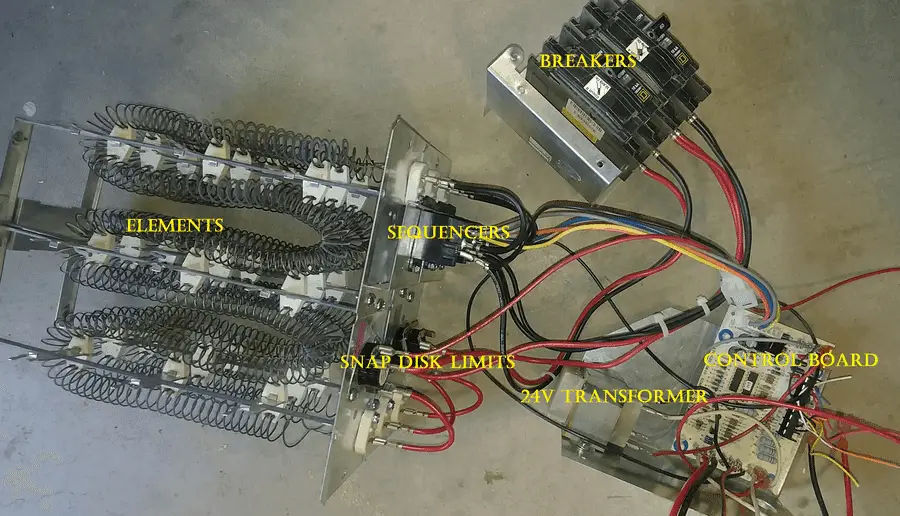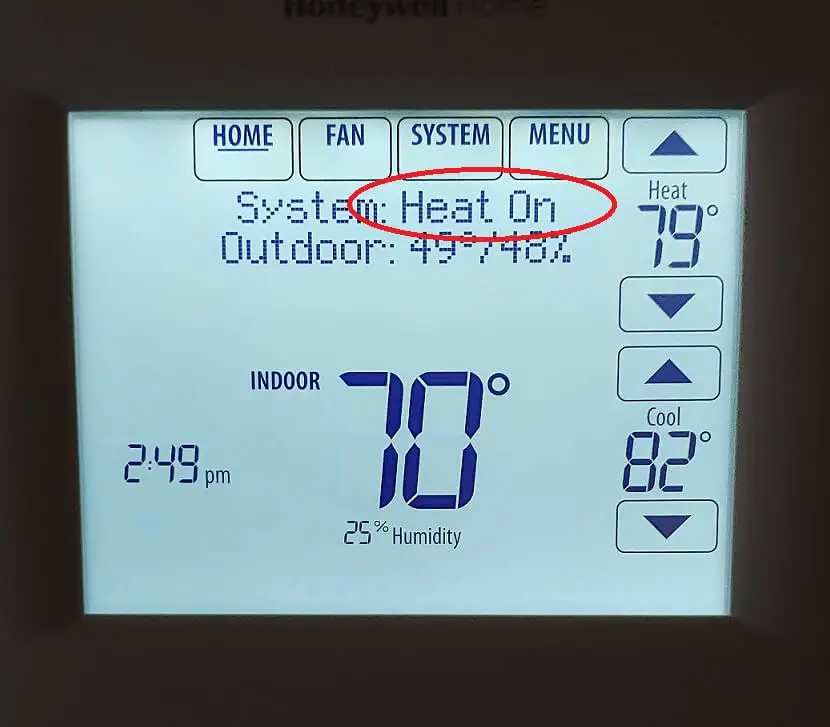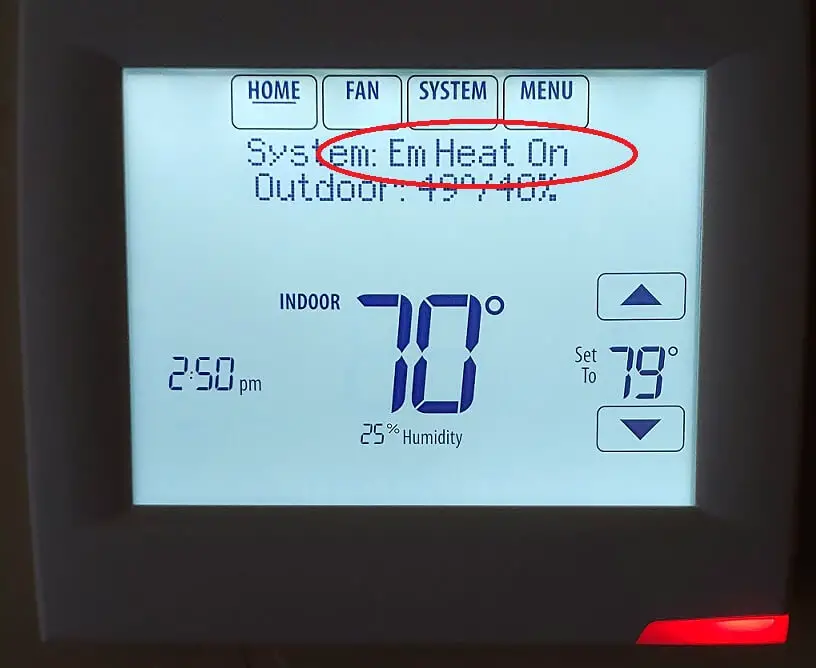Auxiliary heat is displayed in various ways on a thermostat. They use abbreviations like “aux ht” or “em ht”. What does emergency heat mean?
Why does my auxiliary heat keep coming on?
A heat pump system has two sources of heat. The heat pump itself (outdoor unit), and an auxiliary or supplemental source (indoor unit). The auxiliary heat can be electric, gas or fuel oil.
Auxiliary heat comes on to supplement the heat pump in extreme cold. The thermostat setting called Em Ht can be used when the heat pump (outdoor unit) has failed.
If the indoor unit fails, you are pretty much out of luck. Get help quick.
In areas of the country where temperatures dip below freezing a heat pump needs a supplemental source of heat to boost the heat pump and warm the house. And, despite what you may read on other sites addressing this question, don’t turn your thermostat to EM HT when the temp gets below 30 degrees.
If a heat pump is sized and installed correctly the outdoor unit will still produce efficient heat to a much lower temperature than 30 degrees.
The most economical idea for your heat pump system is to get the house to your comfort range in a decent amount of time so the that heat pump can do the work without the use of auxiliary heat. It is widely recommended that you never set back a thermostat for a heat pump to more than 5 degrees. The idea being that the energy consumed by the aux heat is much greater than it would be if you left the temp at the same level.
The image below shows a set of electric furnace elements. These elements act as both auxiliary heat and emergency heat. Emergency heat when the outdoor unit fails and auxiliary heat to supplement the outdoor unit when extreme cold exists.

In the paragraphs above when referring to the heat pump we are speaking of the outdoor unit. Not a package unit where the whole system sets outside on a pad with duct work into the home.
A heat pump for our purposes here is actually a system, consisting of an outdoor unit and an indoor unit. The outdoor unit cannot heat or cool without an indoor unit. But, an indoor unit can heat without the outdoor unit when switched to EM HT.
In the HVAC industry the indoor unit is referred to as an air handler because it handles the air delivery through the furnace, refrigeration coil and the duct system. This air handler can be an electric furnace or fossil fuel such as propane, natural gas, or fuel oil.
Some times these heat pump systems can be referred to as stages of heat. The first stage being the outdoor unit or heat pump and the second stage being the strip heat in the indoor furnace. When the system is running most efficiently the thermostat will read “Heat On”.

When Should You Switch From Heat Pump To Emergency Heat?
There are more than a few reasons to switch on the emergency heat.
- Outdoor fan quits
- Compressor fails
- Freon leak
- Too much ice on coil
- Unit undersized and has never kept up in extreme cold
Best Auxiliary Heat Definition
After absorbing this thought of what auxiliary heat means over and over it seems that the best definition would be accomplished if you were to go to your thermostat and turn on your EM HT.

In the red circle is where you to turn off and on the emergency heat on a Honeywell thermostat. By touching this section until the EM HEAT flashes and pushing DONE you will have manually turned on your EM HT which is actually the same elements and controls that operate Aux Ht. They are one in the same source of heat but called on to heat for different reasons.
Even though they are one in the same your thermostat uses this supplemental heat source in different ways. The thermostat can turn on electric strip heat to supplement the heat pump or you can switch the thermostat to EM HT and turn on the electric strip heat when you want emergency heat.
Best Definition of Emergency Heat For a Heat Pump
A heat source used in a heat pump system that can heat the home in case of a failure in the outdoor unit or refrigeration system.
A typical heat source would be electric, propane, natural gas or home heating oil.
Why Does My Thermostat Say Auxiliary Heat On?
If your air handler is an electric furnace and your thermostat says “aux heat on” then your strip heat is energized to supplement your heat pump either because you turned up the temperature more than a couple of degrees or it’s extremely cold out and your heat pump can’t keep up.

Another possibility why your thermostat says “aux heat on” is that something is wrong with your outdoor unit or heat pump itself.
Some home owners have been told that a heat pump doesn’t work in temperatures below freezing and they switch their thermostat to EM HT.
It’s not an entirely true statement. A heat pump that is sized and working correctly does generate less heat in colder weather . But, it can still generate cheaper and warmer heat when combined with electric heat than it will when operating with straight electric heat.
Your heat pump running in below freezing temperature combined with your strip heat can possible produce a higher duct temperature and satisfy your thermostat setting quicker.
Utility prices are a determining factor. If you have a notion to figure utility prices click here for an energy calculator and judge for yourself.
This can be a puzzling dilemma. So many aspects of this thought about switching to EM HT are very confusing to most home owners and some industry professionals.

Trying to explain which fuel would be best for auxiliary heat for every type of house and for every climate in the nations is near impossible when it can vary even from neighborhood to neighborhood.
Why is My Heat Pump Auxiliary Heat Always On?
Another reason for your thermostat to say “aux heat on” is that something is wrong with your heat pump and perhaps your furnace fan runs all the time. If your heat pump isn’t sized correctly or maybe it’s in need of a good tune up and it’s not running at peak performance. Maybe you’re having a really severe winter.
Or the duct system developed a leak? Return air ducts could be sucking unconditioned air into the house and supply ducts could be leaking your conditioned air into other areas besides your house.
Refrigeration coils can be impacted with dust because of improper filtering or maintenance can cause auxiliary heat to come on more than necessary. If your heat pump is operating correctly it’s best to set it and leave it alone.
Energy costs can rise dramatically when turning your thermostat down more than a few degrees at night for example. The energy consumed by your auxiliary heat coming on to bring your house back up to your comfort temperature in the morning can far exceed what you thought you saved by lowering the temperature.
There are several ways to control how and when the auxiliary heat comes on. Older heat pumps had an outdoor thermostat that would be set at at a temperature called set or balance point. When the set point was reached, which was somewhere around 30 degrees the outdoor thermostat would turn on the auxiliary heat.
How A Heat Pump Works With A Gas Or Oil Furnace As Auxiliary Heat
Originally when heat pumps hit the market they used what was called a fossil fuel switch to govern when the fossil fuel furnace would come on. Today’s thermostats do the same thing as a fossil fuel control without the added relays and expense.
A difference between heat pumps with electric furnaces for back up and heat pumps with fossil fuels is that electric furnaces don’t use fossil fuel as supplementary heat unless there is a gas burning generator at the other end of the power lines.
Indoor coils for gas and oil furnaces that are working with heat pumps have to be placed downstream of the furnace or heat exchanger. Placing a coil of a fossil burning furnace on the return or entering air side of the furnace would prematurely ruin the heat exchanger .
So because the heat pump coil has to be on the supply side of the furnace the heat pump and the furnace cannot run simultaneously. The heat from the furnace would over heat the indoor coil with the heat pump running and pressures in the heat pump compressor and sealed system would go out the roof so to speak.
I Have A Confession To Make About My Water Or Ground Source Heat Pump
I have a confession to make. I have never wired up my auxiliary heat to my water source heat pump. It’s tied to a shallow well and provides a constant 55 degree flow of water to two heat pumps.
The main floor system has heated and cooled the home perfectly for many years. Because the water source is a constant temperature the need for supplementary heat has never been there. Unlike air to air heat pumps with an outdoor unit that’s exposed to all kinds of weather abuse, a water source heat pump will perk along for many more years undisturbed by weather events and calamities.
The need to supplement is just not there. Sure it runs longer in cold weather and it cost more, but hey, it’s in an 80 year old house. I hope this is just another example that helps you to understand the purpose of auxiliary heat. And yes it did fail one time and I had no heat on the main floor because I had no emergency heat.
